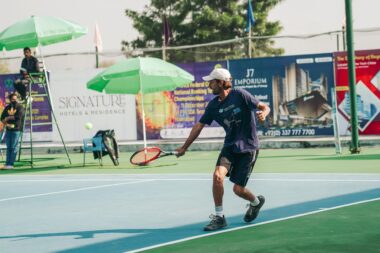Effective Gym Workouts for Tennis Recovery Days
Recovery workouts after intense tennis sessions are crucial for maintaining performance. Engaging in gym workouts helps athletes recover while building strength and flexibility. A structured recovery routine can alleviate muscle soreness, enhance rejuvenation, and prepare the body for upcoming challenges. Prioritizing recovery days will ultimately lead to improved athletic performance in tennis. It is essential for tennis players to understand the importance of integrating gym workouts into their recovery protocols. Focusing on aspects like low-impact exercises, stretching, and mobility work is vital. These recovery sessions can complement on-court practice and reduce the risk of injuries. Moreover, athletes can ensure that they maintain their fitness levels without compounding fatigue. Planning specific workouts for these recovery days provides a balanced approach to enhancing overall physical health. Tennis players should consider incorporating core stability and endurance exercises suited for their needs. Engaging in controlled lifting and flexibility work allows athletes to maintain their muscular balance and prevent tightness. By complementing these workouts with proper nutrition and hydration, players can maximize the benefits of recovery days.
To maintain muscle health during recovery days, consider engaging in resistance training. Low-intensity strength training can target specific muscle groups, benefitting players immensely. Focus on functional movements such as squats, lunges, and push-ups to enhance stability. Incorporating exercises that utilize resistance bands or light dumbbells is beneficial for muscle activation. Each workout can consist of 2-3 sets with 10-15 repetitions, emphasizing quality over quantity. Prioritize control and proper form during these exercises to avoid injuries. Additionally, integrating dynamic stretches provides further benefits during recovery, promoting flexibility. Yoga sessions can also enhance muscle relaxation while improving overall body awareness. Including exercises like downward dog and child’s pose aids in loosening tight muscles and enhancing blood circulation. Maintaining a focus on recovery through these gym workouts ensures improved flexibility in the long run. It’s essential to listen to your body’s signals during recovery, and adjust workout intensity appropriately. Adapting to recovery day needs is fundamental for every athlete. Thus, evaluating your workouts continually forms an integral part of long-term physical preparation. Consistency in these practices yields optimal results throughout the tennis season.
Stretching and Mobility Work for Recovery
Implementing stretching and mobility work into recovery days greatly impacts flexibility and reduces soreness. Focus on both static and dynamic stretches targeting major muscle groups. Stretching the hamstrings, quadriceps, arms, and hip flexors should be part of your daily regimen. Dynamic stretches like leg swings and walking lunges prepare the body for upcoming practices, whereas static stretches help alleviate tension. Specifically, hold each static stretch for 20-30 seconds to gain optimal benefit, ensuring deep breathing throughout the process. Gentle mobility movements can address muscular tightness and improve range of motion. Incorporating drills like shoulder circles and ankle rolls assists in maintaining joint functionality. Foam rolling is another effective tool to incorporate into recovery days, acting as a self-myofascial release technique. This method helps alleviate tightness and improves muscle elasticity. Implementing a routine of foam rolling on key muscle groups used during tennis, particularly after intense practices, optimizes muscle recovery. Staying hydrated and maintaining proper nutrition should accompany these exercises, enhancing overall recovery efforts. Full commitment to recovery sessions will contribute to peak performance during competitive play, reinforcing positive outcomes.
Nutrition plays a vital role in recovery phases, and it’s essential to focus on adequate nutrient intake. Consuming a mix of protein, carbohydrates, and healthy fats post-workout is important for muscle repair. Macronutrients aid in replenishing glycogen stores and promote effective muscle recovery. Tennis players should consider a balanced meal after recovery workouts to support the rebuilding process. For instance, Greek yogurt with honey and fresh fruits makes an excellent post-exercise snack. Hydration is equally crucial, ensuring the body remains replenished with fluids lost during play. Aim to drink water consistently throughout the day to maintain peak hydration levels. Electrolyte-rich drinks may also benefit players after a strenuous workout. Incorporating vegetables and whole grains into meals ensures a healthy mix of vitamins and minerals, aiding recovery. Moreover, planning meals in alignment with training schedules can enhance absorbed nutrients over time. Thus, understanding how nutrition impacts recovery practices fosters significant benefits. Each athlete’s body responds differently, so adapting dietary choices enhances overall effectiveness. Continuous evaluation of nutritional habits can support long-term physical health and improved tennis performance.
Rest and Recovery Techniques
Prioritizing sleep and rest into training regimens is essential for effective recovery. High-performance athletes tend to overlook the value of sleep in conditioning and muscle repair. Aim for at least 7-9 hours of quality uninterrupted sleep each night. Sleep facilitates the release of growth hormones, enabling faster recovery and aiding muscle rebuilding. It’s important to cultivate a relaxing bedtime routine, ensuring optimal conditions for rest. Practices such as wind-down routines involving light reading or meditation help signal the body to prepare for sleep, promoting relaxation. Additionally, consider integrating short naps during the day when needed, particularly after intense training or competitions. Research indicates that even a brief rest can enhance performance outcomes by reducing fatigue. Utilizing recovery strategies like alternating hot and cold baths improves blood circulation and alleviates inflammation. Furthermore, consider practices like gentle yoga or tai chi to enhance mindfulness and flexibility on recovery days. Remember to assess how your body feels, adjusting your efforts as necessary. Emphasizing rest can fundamentally enhance performance, reducing the risk of overtraining during the tennis season.
Incorporating low-impact cardio sessions into your recovery days will enhance blood circulation and boost mood. Engaging in activities like swimming, cycling, or brisk walking is effective while being gentle on the body. These sessions can last anywhere from 20 to 40 minutes, focusing on maintaining a consistent heart rate without extreme exertion. Light cardio contributes positively to overall cardiovascular health, allowing for effective recovery without overstressing joints and muscles. Consider varying your cardio activities to keep things engaging and enjoyable. Incorporating aquatic exercises can be particularly beneficial since they provide resistance without the impact. Alternating between different forms of low-intensity workouts brings variety and eases the strain on specific muscle groups. Furthermore, completing these light cardio sessions facilitates muscle soreness reduction and speeds up recovery. Players can integrate team sports or group classes that emphasize light and engaging activities into their routine. Maintaining social interaction during these workouts provides motivation and camaraderie. The combination of engaging in structured cardio can augment both physical health and psychological well-being during recovery periods in preparation for exciting tennis challenges ahead.
Monitoring Progress and Adjustments
Regularly evaluating workout progress and adjusting routines are crucial steps in ensuring optimal recovery. Keeping track of workout intensity, duration, and how your body feels serves to assess recovery benefits accurately. Utilize tools such as fitness trackers or journals to monitor progress over time. These tools allow you to review your workouts weekly and determine if recovery day sessions are delivering expected results. If your energy levels consistently remain low, consider recalibrating the exercises involved, focusing on gentler activities to promote recovery. Identifying your body’s response to workouts fosters a greater understanding of its needs. Periodic adjustments can include altering rest periods or modifying exercises to better suit physical capabilities. Furthermore, seeking feedback from coaches or sports professionals will enhance recovery strategies. Create a balanced plan centered around active recovery, ensuring athletes remain tuned into their physical states. Incorporating consistent feedback mechanisms allows tennis players to fine-tune their fitness routines significantly. Over time, continuously recalibrating the approach to workouts will lead to greater achievements, reinforcing overall athletic performance and longevity in the sport.
In summary, adopting effective gym workouts for recovery days is essential for tennis players’ overall health. To complement this, ensuring proper nutrition, hydration, and sufficient rest forms an integral part of the recovery process. Each workout-focused phase, incorporating strength, flexibility, mobility, and relaxation exercises fosters physical well-being. Prioritizing a balanced approach to recovery is the key to ensuring a player’s resilience amidst intense training regimes. Maintaining variety in workouts also plays a significant role in keeping motivation levels high throughout the recovery journey. Players are encouraged to engage in low-impact cardio, resistance training, and consider professional guidance to enhance their recovery plans. Synergizing these training components leads to optimal fitness development, promoting professional growth during the tennis season. Additionally, issuing adjustments and evaluating responses will ensure that recovery practices yield meaningful impact. Paying close attention to recovery days will not only improve muscle condition but also significantly influence performance capabilities. Ultimately, consistent integration of these components paves the way for greater success, allowing tennis players to thrive in competitive environments. This comprehensive focus on recovery will lead to long-lasting improvements in strength and performance longevity.





